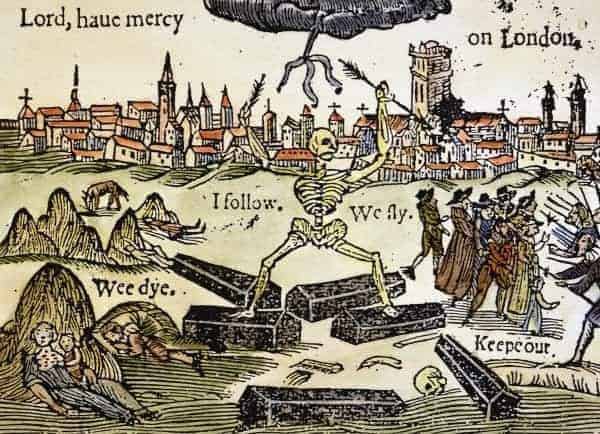The pretty village of Eyam nestles in the hills of the Derbyshire peak district. Once known for its farming and lead mining, modern Eyam is a commuter village, with many of its 900 residents making the daily journey to nearby Manchester and Sheffield. It’s not hard to understand why these city workers prefer to make their home in Eyam, for the village maintains a quintessential picture-postcard prettiness. Its quaint cottages, ancient church and seventeenth-century manor house are also a draw for the thousands of annual visitors to the Peak District. However, this is not the only thing that attracts visitors to Eyam.
About half a mile out of the main village is a curious feature: a wall made out of rough, flat stones, punctuated with unusual openings whose edges have worn smooth with time. The wall is unique for it is the relic of a tragedy and triumph – from Eyam’s past. For in 1666, the people of Eyam took the unprecedented step of isolating themselves and their village from the rest of Derbyshire when the village became infected by the last outbreak of bubonic plague in Britain. This brave action devastated the settlement, but at the same time earned Eyam the reputation as the village that stopped the plague.

The Great Plague of 1665
In 1665, plague once again struck mainland Britain. Some historians believe it took root as early as late 1664, held at bay by the winter months. However, once the winter was over, the plague spread in earnest. The first place it afflicted was the poor London suburb of St. Giles in the Field. From there, the pestilence made its way through other overcrowded, impoverished areas of the city: Stepney, Shoreditch, Clerkenwell and Cripplegate and finally Westminster.
The plague took between four to six days to incubate. By the time its symptoms appeared, it was too late. Victims developed a high fever and vomiting. Excruciating pain wracked their limbs. Then came the tell-tale buboes which formed in the lymph glands, which could swell to the size of an egg before bursting. Infected houses were sealed, the doors marked with a red or white cross with the words “Lord have mercy on us” daubed beneath. Samuel Peeps noted how daytime streets were strangely silent. At night, however, they were active as corpses were collected and carried away in carts for disposal in the great plague pits dug about the city.
People believed that the plague was airborne, possibly because one of the first signs of the infection was that the victims could smell a sweet, sickly fragrance about them. This smell, however, was not the plague but the scent of the victim’s internal organs which were collapsing and rotting. However, because of this telltale odor, people began to carry posies of flowers which they held to their noses to keep the plague at bay. The custom became incorporated in the children’s song about the Great Plague, “Ring a Ring of Roses.”

When the scale of the epidemic became obvious, anyone who could afford to leave London did so. By early summer 1665, the King, his court, and parliament had all fled, leaving behind those citizens who could not afford to abandon their homes and livelihoods. These fortunate few did not return until February 1666 when the plague began to fizzle out. However, out of those left behind, records indicate that between 1665 and 1666, out of a total population of 460,000 as few as 68,596 or as many as 100,000 people died in London of the contagion.
However, although people remember this plague as The Great Plague of London, it afflicted other areas too. Ports such as Southampton were stricken and gradually, aided by trade and by those fleeing infected areas, the plague made its way north. It passed through and infected the towns of the Midlands and then hugged the northeastern side of England, arriving at Newcastle and York. However, rural Derbyshire and the northwest remained relatively safe until, in August 1665, the plague reached Eyam.

